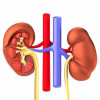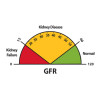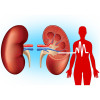
 Dr. Alok Kumar
Dr. Alok Kumar
What is eGFR Blood Test ?
- Who All Require EGFR Test?
- How To Prepare Yourself For EGFR Test?
- How EGFR Test Will Feel To You?
- What Is The Normal Range Of EGFR?
- What Does Low eGFR Results Mean ?
- What Factors Can Affect EGFR?
- What are the Risks of eGFR?
A glimpse into GFR
Clinical assessment of kidney function is central to the practice of medicine. Several methods used for estimating kidney function include glomerular filtration rate (GFR), serum creatinine, urea, and cystatin C.
Among these, GFR is widely accepted as the best measurement of kidney function in health and disease. Its accurate values are essential for optimal decision making of the treatment.
Estimated GFR (eGFR), a test commonly done by laboratories is used to check how well the kidneys are working. It estimates how much blood passes through the glomeruli each minute, which are tiny filters in the kidneys that filter waste from the blood. Thus, eGFR is a crucial tool that determines the capacity of the kidney to clear out waste and water from blood.
Who all require eGFR test?
Estimated GFR test is sometimes done as a routine investigation, or your doctor might recommend it if you have signs of kidney problems.
Various problems that can require eGFR are:
• If you face problems during urination including pain
• If you have to go more often or less for urination, i.e. change in frequency
• Blood, foam, or a brownish color in your urine
• If you are having frequent urinary tract infections
• Swelling or puffiness around your eyes, belly, wrists, or ankles
• Pain in the middle of your back, near your kidneys
• If you have a condition affecting your kidneys, like diabetes, high blood pressure, or heart disease
• If you have a family history of kidney disease.
How to prepare yourself for eGFR test?
• Notify your doctor about any drugs, vitamins, or dietary supplements you are taking before undergoing this test
• However, do not stop taking any medication on our own without the guidance of the doctor
• Tell your doctor if you are pregnant or think you might be as GFR is affected by pregnancy
• Your doctor may tell you to stop taking certain medicines or to not eat certain foods beforehand
• A doctor or nurse will take a sample of your blood for eGFR test
• They will send it to a lab to see how much creatinine is in the blood
• The lab will use a mathematical formula based on the amount they find, along with your age, gender, and race to deduce the results.
How eGFR Test will feel to you?
• When the needle is inserted to draw blood, some people might feel moderate pain or others may feel it like a prick or stinging.
• It can be followed by some throbbing or a slight bruise, which may soon become normal.
What is the Normal range of eGFR?
Normal GFR values are largely over 60 mL/min/1.73 m2 in healthy individuals, before the age of 70 years.
However, as GFR decreases with age, values below 60 mL/min/1.73 m2 can also be considered normal in adults above 70 years.1
According to National Kidney Foundation, normal eGFR variations as per age has been shown in table 1.2
Table 1: Normal eGFR values in regard to different age groups
Age (years)
|
Average eGFR
|
20–29
|
116
|
30–39
|
107
|
40–49
|
99
|
50–59
|
93
|
60–69
|
85
|
70+
|
75
|
Normal value ranges may vary marginally among different laboratories. Some labs use different measurements or test different samples.
Talk to your doctor to understand the meaning of your specific test results.
What does Low eGFR Results Mean?
Abnormal eGFR levels is highly important to understand chronic kidney disease.
Levels below 60 mL/min/1.73 m2 for 3 or more months are a sign of chronic kidney disease. A GFR lower than 15 mL/min/1.73 m2 is a sign of kidney failure and warrants immediate medical attention.
There are five stages of kidney diseases, and its association with eGFR is described in Table 2.2
Table 2: Stages of kidney diseases and their association with eGFR
|
Stages
of Kidney
Disease |
Description |
eGFR
values |
|
1 |
Kidney damage with normal GFR |
90 or above |
|
2 |
Kidney damage with mild decrease in GFR |
60 to 89 |
|
3a |
Moderate decrease in GFR |
45 to 59 |
|
3b |
Moderate decrease in GFR |
30 to 44 |
|
4 |
Severe reduction in GFR |
15 to 29 |
|
5 |
Kidney failure |
Less than 15 |
On the basis of presence of kidney damage and GFR, your doctor can assess the stage of kidney disease, which is a measure of your kidney function.
Your treatment is based on the stage of kidney disease. Speak to your doctor, if you have any questions about your stage of kidney disease or your treatment.
What factors can affect eGFR?
Your result can get affected if you are/have:
• Younger than 18 years
• An elderly individual
• Pregnant women
• A kidney condition or other comorbidity
• More muscle mass than average
• A disease that lowers your muscle mass
• Follow a vegetarian diet
• Obesity.
Consult your doctor, if you have any of the abovementioned conditions.
What are the Risks of eGFR?
Like any other blood tests, there are minor risks involved with eGFR test. Veins and arteries vary in size from one person to another and from one side of the body to the other; hence, taking blood from some people can be more challenging from others.
Some of the risk involved are as follows:
• Excessive bleeding
• Lightheaded
• Multiple punctures to locate veins
• Hematoma
• Infection.
To summarize, majority people are aware that their blood pressure and cholesterol levels are important in knowing their risk for heart and blood vessel diseases. However, very few know about glomerular filtration rate (GFR), a level used to detect kidney problems.
Estimated GFR test is a routine blood test, essential to assess the health of kidneys.
References:
1. Delanaye P, Schaeffner E, Ebert N, Cavalier E, Mariat C, Krzesinski JM, Moranne O. Normal reference values for glomerular filtration rate: what do we really know? Nephrol Dial Transplant. 2012 Jul;27(7):2664-72.
2. GFR (Glomerular Filtration Rate)-A Key to Understanding How Well Your Kidneys Are Working. National Kidney Foundation. Available at: https://www.kidney.org/sites/default/files/docs/11-10-1813_abe_patbro_gfr_b.pdf

Dr. Alok Kumar
Dr. Alok Kumar is Nephrologist at Shri Guru Ram Rai Institute of Medical Sciences, Dehradun.














Please login to comment on this article